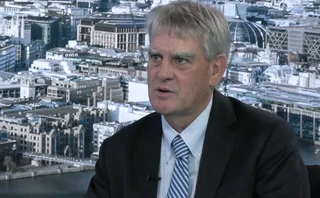
Foreign exchange house of the year: Societe Generale
Structured Products Asia Awards 2018

Competition in the market for foreign exchange structured products was fierce in 2017. As global stock markets soared to record highs, investor interest in forex products waned in favour of equity-linked structures. New ideas were required to pique investor interest.
Societe Generale’s forex derivatives team did just that. Convinced emerging market currencies could outperform the street view against the US dollar, the French bank structured products with capital guarantees to lure private bank clients. It also designed a product linked to the Taiwanese dollar after spotting an attractive entry point based on long-term support levels for the currency.
“In this environment, you have to add value and fulfill other objectives for the end-investors,” says Guillaume Miquel, head of fixed income and currencies (FIC) for Asia-Pacific at Societe Generale. “You want to give them other types of payments so there is still that investment in equities as well as other investments such as forex derivatives.”
The products that succeeded in the past year were the result of Societe Generale’s ability to extrapolate past market behaviour to come up with structures that addressed investors’ long-term fears. Two trades involving emerging currencies were executed over the past 12 months that demonstrated the bank’s propensity for product innovation.
Amid a sustained rally in the US dollar, Asian private banks looked to diversify their portfolios away from the overvalued greenback to emerging currencies. Societe Generale realised low volatility and forward curves in the Korean won, Indonesian rupiah and Chinese renminbi would make for good entry points to structure products with capital guarantees at maturity.
“We were very positive about these currencies, and we could see the dollar interest rate curve was quite low versus local markets’ yield curves,” says Miquel. “It means forwards are still pricing in an appreciation of US dollar versus the local currencies. It was a fantastic market opportunity for the bank.”
Autocallables linked to the worst performance of three currency pairs – INR, IDR and CNH – against the US dollar were sold. An alternative basket contained USD/TWD and USD/KRW. The products had a maturity of between one and three years and two barriers – one on the upside and one on the downside. If the upside barrier is breached the structure knocks out, and investors get their principal back plus a coupon of 5–7%. A snowball memory feature was also included in the structure, adding any missed coupon to the next payment.
The emerging currency autocall products were a huge hit with private bank clients. “Distribution of forex products was reduced because we had a bull market in equities, and we know, as a cross-asset house, that this context is less favourable to fixed-income products,” says Miquel. “However, we managed to be successful in forex callable products, where trading volumes were up by 40%, most of which was on EM currencies.”
In another flagship trade, the French bank leveraged its cross-asset structuring expertise to deliver a hybrid forex product to private bank clients in Taiwan, Singapore and Korea.
The Taiwan dollar had appreciated strongly against the US dollar over the previous two years, but the forex team saw reason to believe the USD/TWD rate would not depreciate below 27.5. The interest rate differential between the two currencies – 1% in Taiwan and 3% in the US – implied a further appreciation in the Taiwan dollar had been priced in by the market.
However, a historical analysis of the interest rate curve of the two currencies showed something different – an incongruity that seemed to point to a good entry point for a product that assumed the forex rate would not depreciate below 27.5.
“If you look at the past 10 years, you will see Taiwanese dollar versus US dollar is trading in a range of 28–33,” says Miquel. “But thanks to the interest rates differential, we were able to price products with a low barrier on Taiwanese dollar at 27.5, which had never been reached in those years.”
In parallel, the bank was able to boost the payout by offering exposure to a rise in US short-term interest rates by adding a credit feature to the structure.
With the sovereign referencing credit-linked notes that Societe Generale developed, investors received a quarterly coupon based on three-month Libor plus a spread derived from the number of days in which the forex rate USD/TWD was superior to 27.5. The notes would redeem at 100% if no credit event was declared before maturity after five years.
Like the emerging currency autocalls, the hybrid forex notes showed that even during a record-setting year for global equity markets, forex-linked structures can be a popular investment for some institutional investors. “We have raised a lot of interest in these so far,” says Miquel. “Not just in Taiwan but also across South-east Asia and South Korea.”
Only users who have a paid subscription or are part of a corporate subscription are able to print or copy content.
To access these options, along with all other subscription benefits, please contact info@risk.net or view our subscription options here: http://subscriptions.risk.net/subscribe
You are currently unable to print this content. Please contact info@risk.net to find out more.
You are currently unable to copy this content. Please contact info@risk.net to find out more.
Copyright Infopro Digital Limited. All rights reserved.
As outlined in our terms and conditions, https://www.infopro-digital.com/terms-and-conditions/subscriptions/ (point 2.4), printing is limited to a single copy.
If you would like to purchase additional rights please email info@risk.net
Copyright Infopro Digital Limited. All rights reserved.
You may share this content using our article tools. As outlined in our terms and conditions, https://www.infopro-digital.com/terms-and-conditions/subscriptions/ (clause 2.4), an Authorised User may only make one copy of the materials for their own personal use. You must also comply with the restrictions in clause 2.5.
If you would like to purchase additional rights please email info@risk.net
More on Awards
Collateral management and optimisation product of the year: CloudMargin
Delivering the modern blueprint for enterprise collateral resilience
Flow market-maker of the year: Citadel Securities
Risk Awards 2026: No financing; no long-dated swaps? “No distractions,” says Esposito
Pricing and analytics: fixed income – Quantifi
Quantifi delivers high-performance, transparent and adaptable pricing and risk analytics for fixed income and credit markets
Derivatives house of the year: Citi
Risk Awards 2026: Rev up, RWAs down, as US bank gets back on track (with added XiNG and XiP)
Technology vendor of the year: SS&C Algorithmics
Risk Awards 2026: From cloud, to chips, to maths tricks – vendor getting more out of existing tech
SS&C Algorithmics: winner’s interview with Curt Burmeister
SS&C Algorithmics wins three categories in this year’s Markets Technology Awards in addition to Technology vendor of the year at the Risk Awards
Best vendor for system support and implementation: Murex
Murex wins Best vendor for system support and implementation at the Markets Technology Awards 2026
Pricing and analytics: cross-asset and structured – Murex
Murex wins Pricing and analytics: cross-asset and structured at the Markets Technology Awards 2026 thanks to its MX.3 platform







